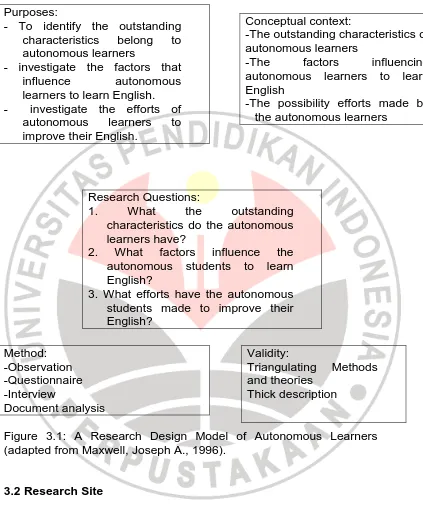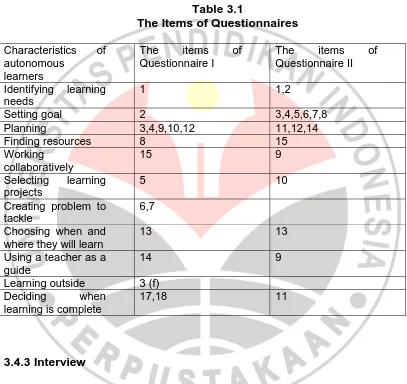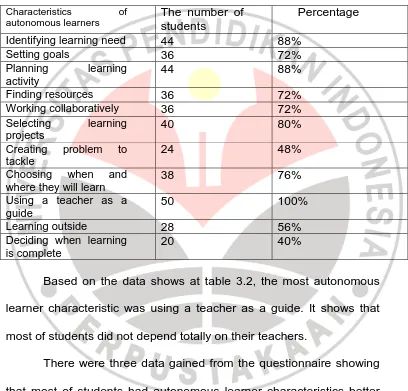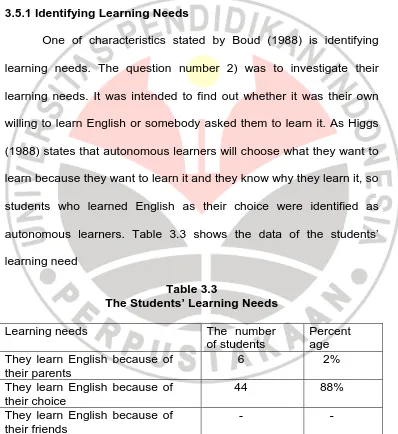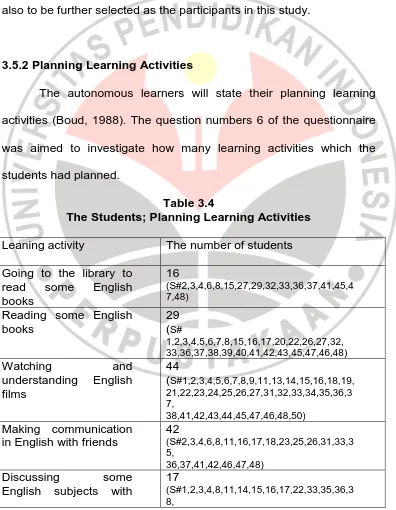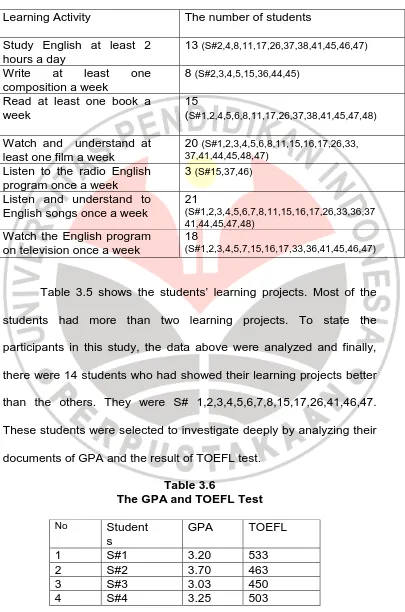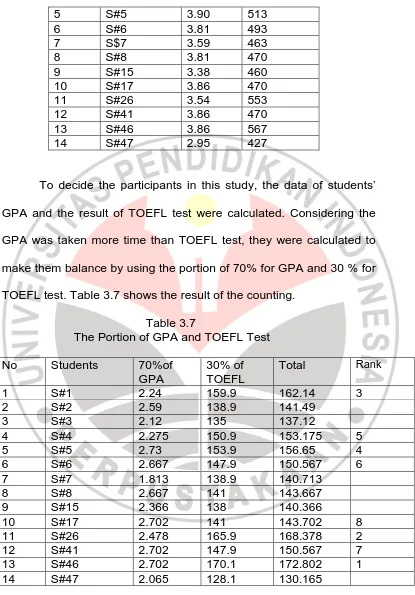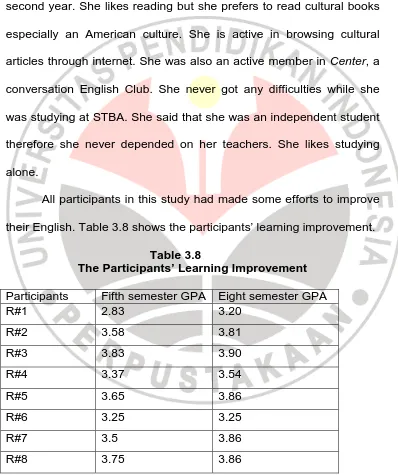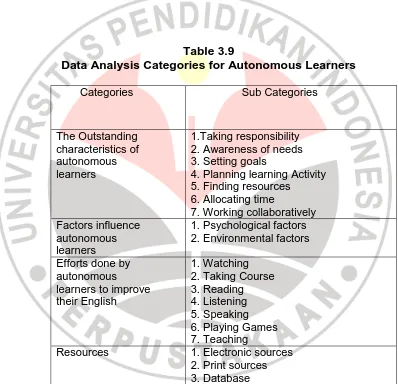CHAPTER III
METHODOLOGY
This chapter deals with the description and account of the steps of what have been conducted in the study. The description involves (1) research design, (2) research site, (3) research questions, (4) data collection techniques, (5) participants in the study, (6) data analysis, and (7) validity.
3.1 Research Design
One of the aims of teaching English is to make students autonomous. Being autonomous learners, they have their own characteristics, they are influenced by some factors, and they seem to make some efforts to improve their English.
This study was aimed to identify the students as autonomous learners, then to determine the outstanding characteristics of autonomous learners. It was purposed also to investigate the factors influencing autonomous learners and the efforts made by autonomous learners to improve their English.
not a method of learning, but an attribute of learner’s approach to the learning process.
This study investigates the autonomous learners. It uses a qualitative method, which is appropriate in understanding process by which events and actions take place (Maxwell, 1996:19).
In addition, this is a case study as it is an examination of a specific phenomenon such as a process. Merriam (1988:16) says that a qualitative case study is an intensive, holistic description and analysis of a single instance, phenomenon, or social unit. Specifically, she conceptualizes the case study as a process which tries to describe and analyze some entities in qualitative, complex and comprehensive terms not infrequently as it unfolds over a period of time.
good achievers. Then, they were asked to fill in the questionnaire consisted the items of autonomous learner characteristics based on Boud’s theory. The answers of questionnaire were read and analyzed to identify the students as autonomous learners or not.
The second step was determined to investigate the outstanding characteristics of autonomous learners by using questionnaire and interview. The interview was also conducted to investigate the factors influencing autonomous learners and their efforts made by the autonomous learners to improve their English.
(adapted from Maxwell, Joseph A., 1996).
3.2 Research Site
This research was conducted in STBA Yapari-ABA Bandung. This college is one of educational foreign languages institutions which one of the aims is to produce students who will be able to speak one Purposes:
- To identify the outstanding characteristics belong to autonomous learners
- investigate the factors that influence autonomous learners to learn English. - investigate the efforts of
autonomous learners to improve their English.
Conceptual context:
-The outstanding characteristics of autonomous learners
-The factors influencing autonomous learners to learn English
-The possibility efforts made by the autonomous learners
Research Questions:
1. What the outstanding characteristics do the autonomous learners have?
of foreign languages fluently. It has vision and mission to produce students to become autonomous learners.
To gain the participants in this study, some of the English students at fifth semester were involved in this study and they were from different classes, from five classes of fifth semester of English department.
3.3 Research Questions
Research questions for this study are:
3.3.1 What the outstanding characteristics do the autonomous learners have?
3.3.2 What factors influence the autonomous learners to learn English?
3.3.3. What efforts have the autonomous learners made to improve their English?
3.4 Techniques of Collecting Data
In conducting this study, there are some techniques of collecting data that have been used. Those are as follow.
3.4.1 Observation
can be observed first hand when a perspective is desire, or when participants are not able or willing to discuss the topic under study (Merriam, 1994:89).
Observation was conducted to select students who could be identified as good achievers. It means they had achievement better than others. Then, they were investigated to identify as autonomous learners.
3.4.2 Questionnaire
In order to gain the written data which identify the students as autonomous learners or not, the questionnaire was also administered. For many good reasons the questionnaire is the most widely used technique for obtaining information from the subject. It is relatively economical, has the same questions for all subjects and can ensure anonymity. Questionnaires can use statements or questions, but in all cases the subject is responding to something written for specific purposes (McMillan, 2001:257).
The second questionnaire was open questionnaire and there were 15 items. It was distributed to investigate some outstanding characteristics that the autonomous learners have. Table 3.1 shows the items of questionnaire.
Table 3.1
Planning 3,4,9,10,12 11,12,14
Finding resources 8 15
says that interview can provide some additional information that was missed in observation and can be used to check the accuracy of the observations (Maxwell, 1996:76).
Interviews with the students who were considered as autonomous learners were intended to gather data to answer research questions. The interview which consisted open-ended questions, were given to eight participants, and were recorded and transcribed. In general, the interview items were the factors influencing autonomous learners and their efforts to improve their English.
3.4.4 Document Analysis
One of data collecting techniques is document analysis as Merriam says that the researchers can use documentary material as data (Merriam, 1988:1). She also adds that this technique is not much different from using interviews or observation.
3.5 The Participants in the Study
The participants in this study were English students of one of the school of foreign languages in Bandung. Considering that there were a lot of students, two kinds of selection were conducted to decide students to be participants in this study. The first was to select the students who were considered as good achievers. It means that they had achieved their study better than others. This was done based on the result of research conducted by L. Dam and L. Lagenhausen (1996 cited in Benson, 2001). They say that autonomous learners will more effective and learn better than non-autonomous learners. It was conducted by observation and by interviewing to their teachers. The second was to select students who were considered as autonomous learners and would be the participants in this study. The questionnaire was used to gain the data.
More than two hundred students of five classes were observed. They were observed to know whether they had achieved their learning well or not. The interview with their lecturer was also conducted to get some information of the students ‘achievement. As a result, there were fifty students considered as achieved students.
could be categorized as autonomous learners. Table 3.2 shows the results of the questionnaire.
Table 3.2
The results of the first questionnaire.
Characteristics of
autonomous learners The number of students Percentage
Identifying learning need 44 88%
Setting goals 36 72%
Planning learning activity
44 88%
Finding resources 36 72%
Working collaboratively 36 72%
Selecting learning
Deciding when learning is complete
20 40%
Based on the data shows at table 3.2, the most autonomous learner characteristic was using a teacher as a guide. It shows that most of students did not depend totally on their teachers.
says that while it is difficult to judge whether learners have become autonomous or not, it is possible to judge whether they are able to produce more effective learning plans, participating more decision making processes, and reflect more deeply on their learning.
3.5.1 Identifying Learning Needs
One of characteristics stated by Boud (1988) is identifying learning needs. The question number 2) was to investigate their learning needs. It was intended to find out whether it was their own willing to learn English or somebody asked them to learn it. As Higgs (1988) states that autonomous learners will choose what they want to learn because they want to learn it and they know why they learn it, so students who learned English as their choice were identified as autonomous learners. Table 3.3 shows the data of the students’ learning need
Table 3.3
The Students’ Learning Needs
Learning needs The number
autonomous learners because it was their choice to learn English. The 2 % of students (six students) were not considered as autonomous learners because they did not know what they wanted to learn. They learned English because their parents asked them to. The six students were S#10, 12, 28, 29, 30, and 49 and they were not taken also to be further selected as the participants in this study.
3.5.2 Planning Learning Activities
The autonomous learners will state their planning learning activities (Boud, 1988). The question numbers 6 of the questionnaire was aimed to investigate how many learning activities which the students had planned.
Table 3.4
The Students; Planning Learning Activities
Leaning activity The number of students Going to the library to
Reading some English books
English subjects with
17
friends 45,47,46) Taking an English
course
14
(S#1,4,7,11,14,15,16,18,23,26,33,38,45,4 6)
Participating
conversation club actively
10
(S#2,3,4,8,11,15,16,17,26,45)
Table 3.4 shows the planning learning activities had been done by the students. Most of the students had more than one activity. According to Benson (2001), the autonomous learners are responsible for their own learning, they routinely initiate and manage their own learning both outside and within the context of formal learning. Therefore students who had many learning activities more than others were taken to be the participants in this study.
Based on the data above, there are 23 students who had planned many learning activities. This shows that they were more active than the others. To gain the participants of this study, these students were investigated deeply.
3.5.3 Selecting Learning Projects
Table 3.5
The students’ Learning Projects
Learning Activity The number of students Study English at least 2
English songs once a week
21
(S#1,2,3,4,5,6,7,8,11,15,16,17,26,33,36,37 41,44,45,47,48)
Watch the English program on television once a week
18
(S#1,2,3,4,5,7,15,16,17,33,36,41,45,46,47)
Table 3.5 shows the students’ learning projects. Most of the students had more than two learning projects. To state the participants in this study, the data above were analyzed and finally, there were 14 students who had showed their learning projects better than the others. They were S# 1,2,3,4,5,6,7,8,15,17,26,41,46,47. These students were selected to investigate deeply by analyzing their documents of GPA and the result of TOEFL test.
Table 3.6
The GPA and TOEFL Test
5 S#5 3.90 513 make them balance by using the portion of 70% for GPA and 30 % for TOEFL test. Table 3.7 shows the result of the counting.
Table 3.7
The data above shows that S# 46, 26, 1, 5, 4, 6, 41, 17 are the eight best students so these eight students were taken as the participants in this study.
These participants were coded as R#1 (S#1), R#2 (S#6), R#3 (S#5), R#4 (S#26), R#5 (S#41), R#6 (S#4), R#7 (S#46), and R#8 (S#17). It is done in order to keep the participants’ privacy, so their real names are not mentioned here. The profiles of them are as following.
English, she is used to doing some efforts, those are filling crossword to enlarge her vocabulary, doing scrabble, watching English films, and listening English songs.
English book everyday. She used to read Reader Digest and Jakarta
Post. She likes studying alone because she did not believe her
friends, she said. Right now she is trying to get scholarship to study abroad.
R#4 was 26 years old. At first, she took diploma program (D3) at STBA and finished it in 2004. Then she worked, she taught English at an English course (AIL). In 2005, she continued her study to take S1 program at STBA. She finished it for one year, in 2006. She likes English since she was an elementary school student at fourth year although she did not get an English subject at her elementary school. She started to learn English from her brother’s English book. She tried to read it and tried to do the exercises of the book. She did it alone; she did not ask her brother or anyone else. She always watches films, listens English songs, reads an English novel. To improve her English, she is used to speaking English everyday. She has some best friends who always make communication with her in English. They are English teachers too. So, whenever she has got any problems with her English, she discusses with her friends.
He also always asked her brother to translate the English songs into Indonesian. Then, he tried to memorize any new vocabulary he found. When he was studying at STBA, he tried hard to improve his English. He spoke English with his best friends and if they spoke Bahasa Indonesia they had to pay two candies for one Indonesian word. He did it everyday. He took part actively in ASES and he was a member of Center. It is an English conversation club.
R#6 was 24 years old. She likes English very much. She liked it for the first time when she was an elementary student. She learnt English from her parents, her brothers, and her relatives in abroad. She learnt English also from films especially series films (Mc Gryver and Beverly Hill). She has ever taken an English course for six months at EF. She improved her English by making communication through internet with her relatives in abroad or with her father’s guests from abroad who stay a night at her father’s inn.
R#8 was 23 years old. She likes English for the first time when she studied it for the first time (when she was an SMP student). She took an English course for four years. Then she taught English for the first time at her English course when she was an SMA student, at second year. She likes reading but she prefers to read cultural books especially an American culture. She is active in browsing cultural articles through internet. She was also an active member in Center, a conversation English Club. She never got any difficulties while she was studying at STBA. She said that she was an independent student therefore she never depended on her teachers. She likes studying alone.
All participants in this study had made some efforts to improve their English. Table 3.8 shows the participants’ learning improvement.
Table 3.8
The Participants’ Learning Improvement
Participants Fifth semester GPA Eight semester GPA
R#1 2.83 3.20
R#2 3.58 3.81
R#3 3.83 3.90
R#4 3.37 3.54
R#5 3.65 3.86
R#6 3.25 3.25
R#7 3.5 3.86
3.6 Data Analysis
The steps in the analysis included the following.
3.6.1 The raw field notes from research’s observation were re-written and read.
3.6.2 The data obtained from the interview with teachers were analyzed.
3.6.3 The data obtained from the first questionnaire was calculated. The first step was analyzing the students’ learning need. The second was analyzing the students’ planning learning activities. To analyze students’ selecting learning projects was the third step.
3.6.4 The data obtained from the students’ learning documents, GPA and TOEFL test was calculated.
3.6.5 To conduct the interview to autonomous learners 3.6.6 The data obtained from the interview were transcribed.
3.6.7 The data obtained from the interview was then identified into some tentative ideas of outstanding characteristics autonomous learners and the factors influencing autonomous learners and the efforts made by them to improve their English. 3.6.8 The next step was making use of coding. Strauss (1987 cited in
comparison of the data within and between these categories and that aid in the development of theoretical concepts.
3.6.9 The last step was taking out the conclusion about the study. Table 3.7 summarizes data analysis categories for autonomous learners.
Table 3.9
Data Analysis Categories for Autonomous Learners
Categories Sub Categories
Resources 1. Electronic sources
2. Print sources 3. Database
3.7 Validity
says that qualitative researchers are able to use many strategies as possible to enhance validity. Therefore a number of techniques are used to ensure the validity, those are:
3.7.1 Triangulation
Triangulation is using multiple methods of gathering data and multiple sources of data to confirm the emerging findings (Merriam, 1988:169). To ensure the validity of this research, data sources: field notes and transcripts, were triangulated. Four techniques of collecting data were also applied: observation, document analysis, interview, and questionnaire. Those were used to identify the outstanding characteristics of autonomous learners, the factors influencing them, and the efforts made by the autonomous learners to improve their English.
3.7.2 Thick Description
